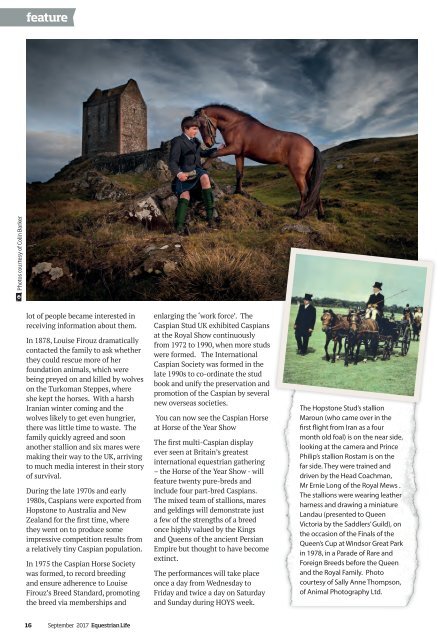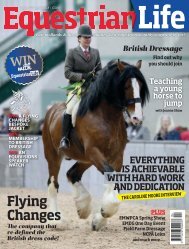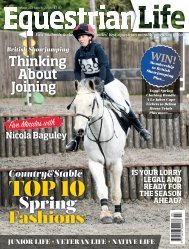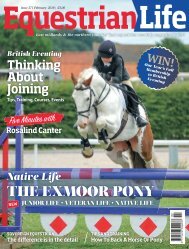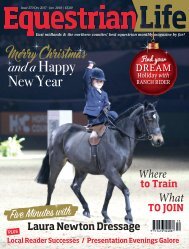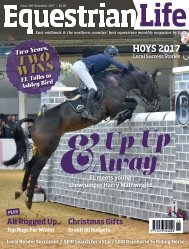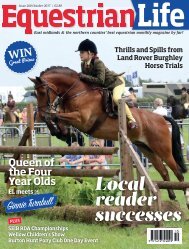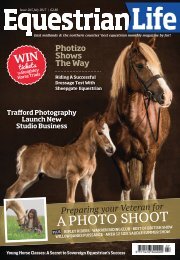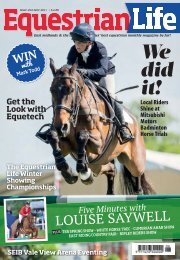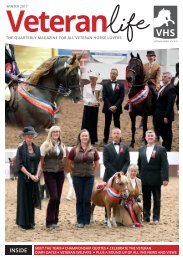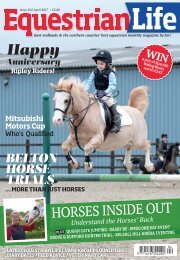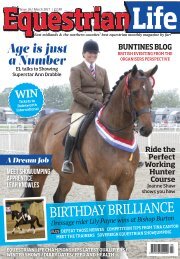Equestrian Life September 2017 Issue
The leading regional monthly for the East Midlands and Yorkshire
The leading regional monthly for the East Midlands and Yorkshire
You also want an ePaper? Increase the reach of your titles
YUMPU automatically turns print PDFs into web optimized ePapers that Google loves.
feature<br />
Photos courtesy of Colin Barker<br />
lot of people became interested in<br />
receiving information about them.<br />
In 1878, Louise Firouz dramatically<br />
contacted the family to ask whether<br />
they could rescue more of her<br />
foundation animals, which were<br />
being preyed on and killed by wolves<br />
on the Turkoman Steppes, where<br />
she kept the horses. With a harsh<br />
Iranian winter coming and the<br />
wolves likely to get even hungrier,<br />
there was little time to waste. The<br />
family quickly agreed and soon<br />
another stallion and six mares were<br />
making their way to the UK, arriving<br />
to much media interest in their story<br />
of survival.<br />
During the late 1970s and early<br />
1980s, Caspians were exported from<br />
Hopstone to Australia and New<br />
Zealand for the first time, where<br />
they went on to produce some<br />
impressive competition results from<br />
a relatively tiny Caspian population.<br />
In 1975 the Caspian Horse Society<br />
was formed, to record breeding<br />
and ensure adherence to Louise<br />
Firouz’s Breed Standard, promoting<br />
the breed via memberships and<br />
enlarging the ‘work force’. The<br />
Caspian Stud UK exhibited Caspians<br />
at the Royal Show continuously<br />
from 1972 to 1990, when more studs<br />
were formed. The International<br />
Caspian Society was formed in the<br />
late 1990s to co-ordinate the stud<br />
book and unify the preservation and<br />
promotion of the Caspian by several<br />
new overseas societies.<br />
You can now see the Caspian Horse<br />
at Horse of the Year Show<br />
The first multi-Caspian display<br />
ever seen at Britain’s greatest<br />
international equestrian gathering<br />
– the Horse of the Year Show - will<br />
feature twenty pure-breds and<br />
include four part-bred Caspians.<br />
The mixed team of stallions, mares<br />
and geldings will demonstrate just<br />
a few of the strengths of a breed<br />
once highly valued by the Kings<br />
and Queens of the ancient Persian<br />
Empire but thought to have become<br />
extinct.<br />
The performances will take place<br />
once a day from Wednesday to<br />
Friday and twice a day on Saturday<br />
and Sunday during HOYS week.<br />
The Hopstone Stud’s stallion<br />
Maroun (who came over in the<br />
first flight from Iran as a four<br />
month old foal) is on the near side,<br />
looking at the camera and Prince<br />
Philip’s stallion Rostam is on the<br />
far side. They were trained and<br />
driven by the Head Coachman,<br />
Mr Ernie Long of the Royal Mews .<br />
The stallions were wearing leather<br />
harness and drawing a miniature<br />
Landau (presented to Queen<br />
Victoria by the Saddlers’ Guild), on<br />
the occasion of the Finals of the<br />
Queen’s Cup at Windsor Great Park<br />
in 1978, in a Parade of Rare and<br />
Foreign Breeds before the Queen<br />
and the Royal Family. Photo<br />
courtesy of Sally Anne Thompson,<br />
of Animal Photography Ltd.<br />
16 <strong>September</strong> <strong>2017</strong> <strong>Equestrian</strong> <strong>Life</strong>


